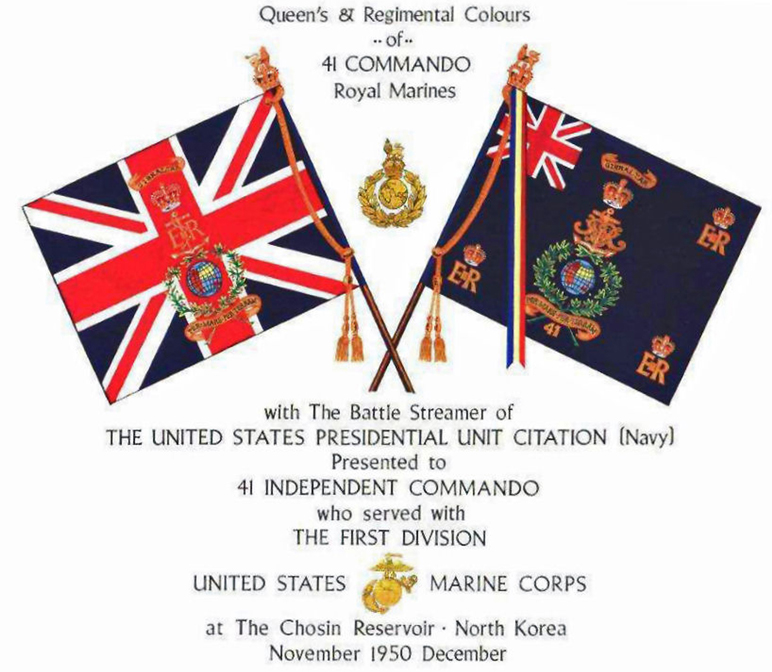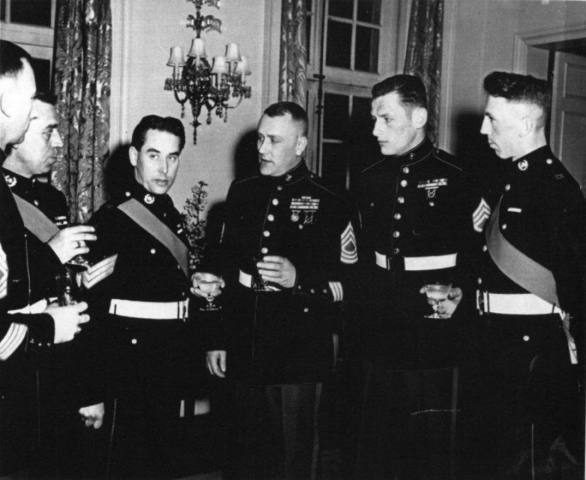'41 Independent Commando RM'
In October 1942 the 8th RM Battalion was disbanded and those who volunteered for, and passed the training, formed a new 41RM Commando. The Commando saw service in WW2 at Sicily and Salerno, Normandy and Walcheren, and the advance through Holland into West Germany. At the end of the war 41 RM Commando was disbanded.
In August 1950 a new 41 Independent Commando was formed at Bickleigh specifically for the war in Korea. It was completely equipped by United States forces on its arrival in Japan and was commanded by Lieut. Col. D.B. Drysdale DSO, OBE, RM, [view] in the first instance, and later by Lieut. Col. F.N. Grant RM.
During its service in Korea the Commando carried out a number of successful amphibious raids on the Korean coastline, chiefly with the object of destroying the coastal communications. At the same time it succeeded in tying up large Communist forces in coastal defence. When the Chinese entered the war the Commando was attached to the 1st US Marine Division USMC, and it took part with this Division in the historic breakout from the Chosin Reservoir in December 1950.
Less than 18 months after it was formed this now famous Commando was disbanded on 22nd February 1952. Some of the men were transferred to the 3rd Commando Brigade in Malaya, ten officers and a hundred-and-thirty men returned home in the Empire Orwell *.
In 1957 it was awarded a United States Presidential Unit Citation for services with the 1st Division United States Marine Corps seven years earlier at the Chosin Reservoir, North Korea.
In 1960 41 Commando RM was reformed and saw service in Northern Ireland and with the UN Forces in Cyprus until it was again disbanded in 1980.
The Commando Roll of Honour for Korea [View here]
View Gallery images of RM Commandos post WW2
* Globe and Laurel, March-April 1952 edition.
'Parliamentary response about Commandos in Korea'
HC Deb 13 December 1950 vol 482 cc1143-6.
Mr. Driberg asked the Parliamentary Secretary to the Admiralty if he will publish in HANSARD a summary account of the part so far played in the Korean campaign by the 41st Independent Commando, Royal Marines, including a statement on the present whereabouts and function of this unit and the number of casualties sustained.
Mr. Callaghan - "Yes, Sir. I am arranging for this to be done."
"Following is the table:
Mr. Driberg - "Without raising undue hopes, can my hon. Friend say whether the news announced last Friday afternoon, that a number of Marines who had been thought lost had, in fact, been rescued, may enable him to diminish somewhat the terribly long list of those missing which was published earlier the same day?
Mr. Callaghan - "I am afraid not. No operational reports have yet been received about this fighting. I can say, however, that seven other ranks who were reported missing are now known to have been either wounded or killed. That is as far as I can go. "
"Following is the account:
'Unit Citation 41 Ind. Cdo RM' image
Presentation of the United States of America Presidential Unit Citation for 41 Independent Commando RM at the American Embassy 1957. Photo courtesy of Bob Carr USMC via Glenn Eves.

